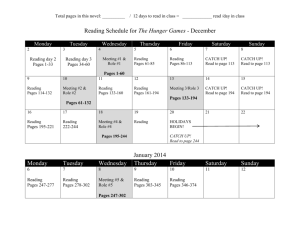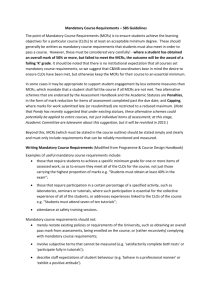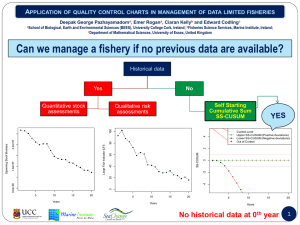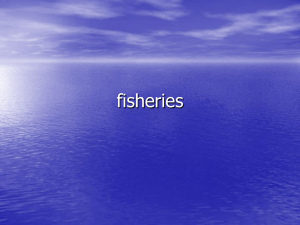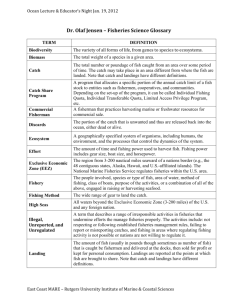Regulations and rules pertaining to the catches and landings of
advertisement
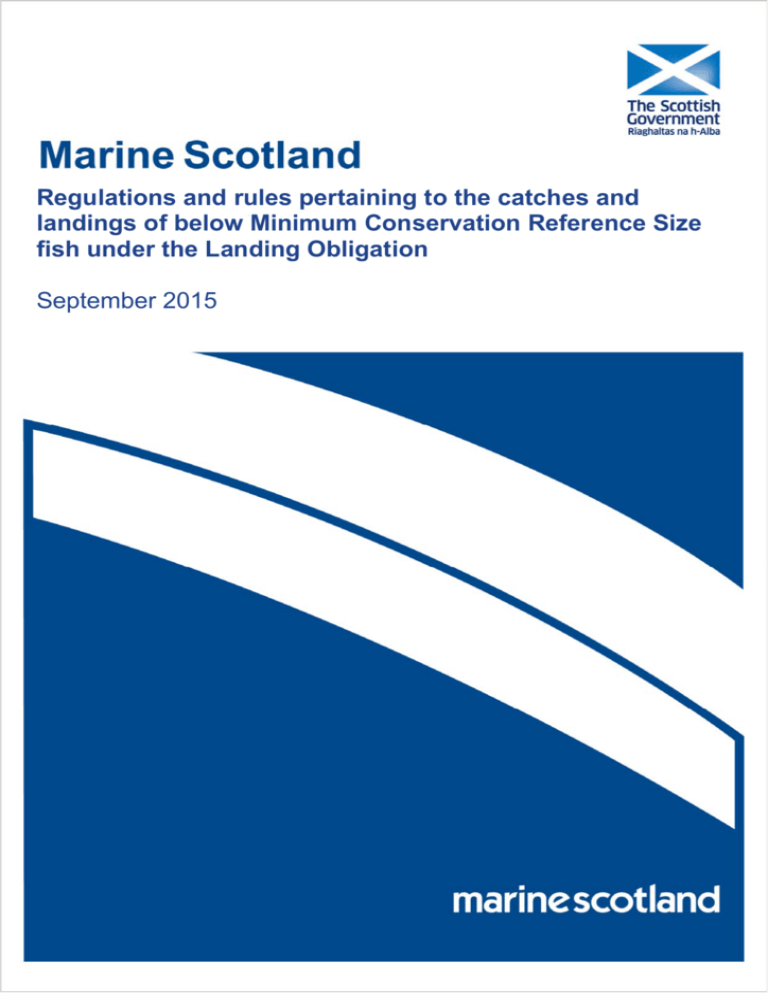
Regulations and rules pertaining to the catches and landings of below Minimum Conservation Reference Size fish under the Landing Obligation September 2015 Purpose and Background 1. The purpose of this Guidance Note is to explain the requirements concerning the catching, landing, storage, marketing and transportation of catches of species subject to the landing obligation which are below the Minimum Conservation Reference Size (MCRS). This Guidance Note will be of immediate interest to fishing vessels, ports and harbours, fish markets, processors, enforcement authorities and other businesses that handle and manage Category 3 animal by-products (ABP). 2. This Guidance Note has been produced by Marine Scotland in conjunction with the Animal and Plant Health Agency (APHA) and Food Standards Scotland. Minimum Conservation Reference Size (MCRS) 3. The Minimum Landing Size will be replaced by a Minimum Conservation Reference Size (MCRS) with the aim of continuing to ensure the protection of juvenile marine organisms. In line with the phased implementation of the landing obligation in the different sea areas, catches of species subject to the landing obligation and below the MCRS will have to be landed and counted against quota. By 2019 all catches of species subject to the landing obligation and below the MCRS will have to be landed and accounted for. Certain exemptions may allow permitted levels of below MCRS catch to be discarded. If secured these will be detailed in the regional Discard Plans. Vessel eligibility and quantities will then be agreed. 4. No changes have been made to the minimum sizes for species in the fisheries prosecuted by the Scottish fleet. 5. The landing obligation applies only to quota species. Catches of undersized species not subject to the landing obligation cannot be retained on board, landed or sold but should be returned to the sea immediately as is currently the case. Animal By-Product Rules and Requirements 6. ABPs are defined as: entire animal bodies, parts of animals, products of animal origin, or other products obtained from animals that are not fit or not intended for human consumption. They must be dealt with in accordance with strict regulations designed to prevent harm to people, animals and the environment. Controls on ABPs in Scotland are enforced under the Animal By-Products (Enforcement) (Scotland) Regulations 2013. 7. Below MCRS catch is defined as fit for human consumption but not intended for direct human consumption. Under the landing obligation, MCRS catches will be classified as a Category 3 ABP. Category 3 represents the lowest risk ABP material. Given the low level of risk attached to below MCRS catch, Marine Scotland, APHA and Food Standards Scotland have agreed that ABP regulations will be applied to this proportion of the catch in a lighttouch and proportionate manner. 1 Responsibility and Ownership 8. The vessel owns and is responsible for the catch that it catches and lands. This remains the case until the point of first registered sale. Responsibility for handling, use and storage of the catch in line with ABP regulations is then transferred to the buyer. The vessel is responsible for disposing of catch which is not sold. Vessels are expected to land only to approved facilities and/or to ensure that the catch is transported on ABP-approved vehicles. 9. The site owner is responsible for ensuring that a given landing point or a storage space is approved to handle and store ABP by the APHA, and for its maintenance - including structural, operational or record-keeping issues. The Application of ABP Regulations to Below MCRS Catch Storage and handling requirements on-board a fishing vessel 10. At sea a vessel and its catch are outwith the remit of ABP regulations. Therefore fishing vessels do not need to apply for ABP approval. The regulatory instrument that determines how the catch is handled and stored is the Common Fisheries Policy (CFP) which applies ‘ABP-like’ controls. These ‘ABP-like’ controls apply from the point at which fish is sorted onboard the vessel. 11. The Omnibus Regulation (EU regulation 2015/812) requires that: Catches below MCRS must be stored separately from the catch destined for human consumption. They must be stored in boxes separate from the rest of the catch. Boxes of below MCRS catch can be stored in the hold or on the deck with the rest of the catch. Below MCRS catch can be stored in standard fish boxes. Below MCRS catches do not need to be separated by species. Catches below MCRS must be labelled ‘not for human consumption’ with the label detailing the vessel’s name, PLN and landing port for traceability purposes. All catches below MCRS must be recorded by species and weight in the landings declaration and logbook or elog. 12. It is vital that below MCRS fish is handled and stored as if intended for human consumption. Correct handling will protect the marketable catch from risk of contamination and help ensure the below MCRS catch is treated as a category 3 ABP and that a light-touch approach is applied. Fish left to decompose run the risk of being downgraded to category 2 ABP. This reduces the options for the catch and its value, and requires more onerous handling and storage requirements to comply with ABP regulations. 13. Catches of quota species below MCRS must be counted against quota. The proportion of the catch intended for human consumption must continue to be handled in accordance with food safety law. Rules pertaining to different landing scenarios 14. ABP legislation is applied to the catch as soon as it is landed on the quayside. This occurs regardless of whether the catch is landed straight to market, stored before uplift or consigned and transported elsewhere. ABP registration applies to the area where the catch 2 is handled – therefore ABP approval is given to the ‘operator’ of the site, not to the person landing the catch. 15. Ports and markets, where below MCRS catch will be stored, will need to be registered and be approved as handling and storage sites by the APHA before 1 January 2016. A handling and storage site covers premises carrying out storing, cutting, chilling, freezing or salting and other low risk handling processes but not processing. There is currently no cost to register, but this may change in the future. Details of the process and the ABPR3 registration form can be found at: https://www.gov.uk/animal-by-product-categories-siteapproval-hygiene-and-disposal. 16. Please note, ports and markets that have processes in place for removing unsold fish from the market should already be registered and approved by the APHA. In these cases no further action is required. Fish landed directly into or transported to market Catch stored inside the market on the main floor or in chill facilities 17. Approved conditions and arrangements may vary between markets and depend upon site specific conditions that will be laid out and agreed with the APHA during the registration process. General principles have been agreed between the governing bodies that will act as a guide for this process. 18. In line with the light-touch application of ABP regulations to below MCRS catch, site operators will be able to handle and store the catch in an APHA approved market alongside the catch intended for direct human consumption. This reflects current practices concerning unsold fish and the very low risk posed by the below MCRS catch. 19. Adequate separation - proportionate to the low level of risk - should be implemented. For example, below MCRS catch should be stored in an identifiable area or corner of the market that allows for visible separation from the catch destined for direct human consumption. The holding area inside the market does not require separate approval or registration as it will be contained within the market’s approval under hygiene regulation (EC) 853/2004. Although the market may be approved under food law, ABP approval as a handling facility is required in order to receive the non-marketable fish from vessels. The process for applying for ABP approval is detailed at paragraph 15 above. 20. If the catch is to be stored in the market in a chill facility alongside catch for direct human consumption, suitable separation should be implemented. For example, catches below MCRS should be stored on a separate shelf or in an identifiable corner of the store. 21. The catch can be stored in standard fish boxes and must remain labelled as ‘not for human consumption’ and reference the vessel and port of origin to ensure traceability. Catch which is transported from the market to a buyer or other outlet 22. In line with regulation EC 853/2004 catches below and above MCRS can be transported together on the same vehicle as long as they have been handled and stored under identical conditions and there is adequate separation proportionate to the low level of risk. 3 23. Below MCRS catch can be transported in standard fish boxes. During transportation the below MCRS catch should be stored separately from the rest of the catch in an identifiable area or corner on the vehicle and should remain labelled. The vehicle must be ABP and hygiene regulation approved or work as a transporter for an approved site. See paragraph 15 for registration details. Catch which is stored outside the market 24. If the catch is not to be stored on the market floor but outside the market in a dedicated storage unit (collection bins, micro digesters, silos, composters etc.) then the storage facility and the operator of the facility must be approved by APHA. If the storage units are situated on the quayside in an area under the jurisdiction of the port authority, the port authority will be the designated site operator for the facility. 25. Responsibility for the operation of storage facility in terms of registration, upkeep and record keeping, lies with the site owner. The application process for a storage plant is not deemed onerous however certain standards must be met. The owner of the storage plant will need to complete an application and send it to APHA. Information on this process can be found at: https://www.gov.uk/handling-and-storing-animal-by-products 26. Once the plan of operation has been approved, it will be subject to risk-based inspection from APHA. On account of the minimal health risk it is not expected that rigorous controls will be applied to storage plants holding below MCRS fish. Premises are likely to be inspected once a year unless APHA have a reason to visit. Catch landed onto beaches, slipways or small harbours with no formal infrastructure Catch which is placed straight onto haulier transport for transportation to buyer, market or hub port 27. If the transporting vehicle is ABP approved, or works as a transporter for a site already approved, the landing area does not need to register to handle ABPs. On the vehicle, the below MCRS catch can be transported with catch destined for direct human consumption provided it has been handled and stored on the vessel under identical conditions and there is adequate separation proportionate to the low level of risk. Below MCRS catch can be transported in standard fish boxes. During transportation the below MCRS catch should be stored separately from the rest of the catch in an identifiable area or corner of the vehicle and must remain labelled. Catch which is stored for collection, uplift or for use as bait in chill facilities, micro digesters, silos or composters. 28. If below MCRS catch is to be stored for any period of time, the storage facility in which it is held and the operator of the facility must be approved by APHA. 29. Responsibility for the operation of the storage facility in terms of registration, upkeep and record keeping, lies with the site owner and not the person landing the catch. The application process for a storage plant is not deemed onerous however certain standards must be met. The owner of the storage plant will need to complete an application and send it to APHA. Information on this process can be found at: https://www.gov.uk/handling-and-storinganimal-by-products 4 30. Once the plan of operation has been approved, it will be subject to risk-based inspection from APHA. On account of the minimal health risk it is not expected that rigorous controls will be applied to storage plants holding below MCRS fish. Premises can expect to be inspected once a year unless APHA have reason to visit. Catch which is taken from the vessel and exchanged directly as pot bait 31. Direct pot bait exchanges between vessels do not require ABP approval. If the bait is stored for any amount of time before being exchanged then the same processes as those pertaining to the situation described at paragraphs 28 – 30 apply to the storage unit and the site operator. Alternative arrangements 32. A hub port system could be put in place that would enable a designated port to act as a storage hub for nearby smaller ports. This arrangement would minimise ABP approval requirements and enable below MCRS fish to be stored and bulked until collection is economically viable. Catches destined for outlets such as fishmeal can be stored for up to two weeks. 33. Under this option only the main hub port would require ABP approval for the storage container. The storage container and site operator would need to be approved in line with the requirements set out in paragraph 15 for storage units. The satellite supplier ports would not require ABP registration or approval if the below MCRS catch was put on to ABP approved vehicles for transportation. Activity in the supplier ports would be monitored through the tracing of consignments. The port of origin and vessel should be identifiable on the labelled boxes. Documentation 34. All catches below MCRS must be recorded by species and weight in the landings declaration and logbook or elog. Catches below MCRS must be labelled ‘not for human consumption’ with the label detailing the vessel’s name, PLN and landing port for traceability purposes. 35. When below MCRS fish is being transported to market or elsewhere it should be accompanied by a commercial document that details: The date of transport, A description of contents including ABP category and quantity, An address of origin and destination, and contact names at both, Approval or registration numbers for the factory or vehicle, The signature of whoever is responsible for the contents. Marketing and permitted uses of below MCRS catch 36. The CFP has restricted the marketing of below MCRS catch in order to avoid jeopardising the protection of juvenile marine organisms and prevent activities specifically devoted to catching marine organisms below MCRS. The restriction in Article 15/11 of the reformed CFP (EU regulation 1380/2013) is that the use of catches below MCRS will be restricted to purposes other than direct human consumption. 5 37. The catch below MCRS can be used for a wide range of options outside direct human consumption if it is handled correctly on account of its low risk. Use and disposal of the catch must be in line with its status as a category 3 ABP. Permitted uses of below MCRS catch: Direct pot bait exchanges and the establishment of local bait markets Fish meal plants in Aberdeen and Shetland Fish oil Landspreading and fertiliser Raw material in pet food Composting Feed additives Pharmaceuticals and cosmetics Rendering Anaerobic and aerobic digestion / energy recovery Incineration Non-permitted or restricted uses of below MCRS catch: Below MCRS catch cannot enter the food chain for direct human consumption. This includes use in food additives. Designation of the catch as an ABP is an irreversible decision. Landfill - Since 2006 the direct landfilling of any form or raw or untreated seafood waste has not been permitted. Until the end of 2015, cooked shellfish products may still go to landfill. From 2016, this is no longer an option. Limitations exist on the use of Nephrops for fishmeal. As Nephrops deteriorate quickly and press poorly their use for fishmeal in any significant volume poses challenges. Moreover Nephrops shells would not be accepted as they do not present a source of protein. United Fish Industries (UFI) have confirmed that the use of Nephrops would only be accepted by specific arrangement and in general their use in fishmeal should not be encouraged. 38. Local solutions may be required to manage small quantities of fish landed in more remote and smaller locations. The use and extension of existing infrastructure that handles unsold fish or fish for outlets outside direct human consumption should be utilised and improved where practicable in order to guard against undue investment. 39. The UFI fish meal plant in Aberdeen and Shetland Fish Products in Shetland have confirmed the ability to process excess material and support a solution for below MCRS catches. Current collection and transport services connect key ports and processing areas to UFI in Aberdeen. In more remote and/or smaller locations where logistical issues may present a barrier, UFI are keen to meet and work with skippers and port managers to establish mutually beneficial logistical solutions. It is to be noted that poor quality fish material could not be accepted so it is vital that below MCRS fish is handled and stored as if intended for human consumption. This does not in any way indicate an endorsement of UFI or Shetland Fish Products over any other potential supplier of such services. Support for the onshore sector through the European Maritime and Fisheries Fund 6 40. The European Maritime and Fisheries Fund may be able to support activity throughout the supply chain. In respect of the impact of the landing obligation and fish below MCRS, the main areas of support which may be available are: On board the vessels in respect of the purchase of selective gear to reduce catches below MCRS, or to store and process fish on the vessel. On shore in respect of facilities for landing, storage and marketing of catches. On shore support for processing and adding value to catches, particularly when this is undertaken by fishermen. Storage aid through Producer Organisations to cover costs of fish not sold on the market. Wider assistance available to support advice, business planning, training and marketing. 41. Support cannot assist disposal costs or the transport costs of fish being moved from the point of landing to another location out with the port. 42. Levels of assistance will vary depending on the type of projects being undertaken and who is undertaking such projects. For example, projects which have a wider sectoral benefit can receive up to 100% support. For projects which have benefits to a single business or individual the maximum intervention rate will generally be 50%. 43. At present negotiations continue with the European Commission on the EMFF Operational Programme. However it is hoped that the scheme will launch at the end of October 2015. Applications will be made on line with an e system and guidance forthcoming. For more information visit: http://www.gov.scot/Topics/marine/grants-subsidies Additional information on the implementation of the landing obligation can be found at: http://www.gov.scot/Topics/marine/Sea-Fisheries/discards/fAQ 7

